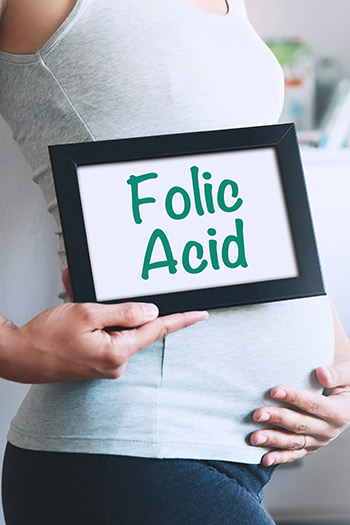Folate & Pregnancy

Folate is a B vitamin that can be found naturally in foods. In its synthetic form, folic acid is added to fortified foods, as well as supplements. This little vitamin serves a crucial role in your body, especially during pregnancy.
Years ago, studies found the consumption of folic acid prior to conception and within the first trimester of pregnancy has the power to reduce the incidence of neural tube defects (NTDs) by 50-70%. This prompted the Food and Drug Administration in 1998 to require certain grain foods (enriched breads, cereal, flour, pasta, rice, etc.) be fortified with folic acid to help increase women’s intakes.
How does folic acid prevent NTDs?
Folate helps in cell growth, division and replication. Therefore, it is one of the nutrients needed early in pregnancy to ensure all goes well while fetal cells grow and multiply to form baby. NTDs occur when the tissues of the brain and/or spinal cord do not close completely (i.e.: anencephaly or spina bifida). Depending on the degree and region affected, infants may have paralysis, be stillborn or die shortly after birth.
According to the Center for Disease Control and Prevention (CDC), there are 3,000 cases of neural tube defects each year in the United States. Therefore, it is important for women of childbearing age to meet the recommended daily allowance guideline of at least 400 micrograms micrograms (mcg) of dietary folate equivalents (DFEs) per day and increase to 600 mcg DFEs during pregnancy.
Women who are pregnant, or could become pregnant, should consume folate and folic acid from a variety of sources including fruits, vegetables, fortified grains, beans, peas[1] and a supplement.
[1] National Institutes of Health. Folate Fact Sheet for Health Professionals. Accessed April 26, 2021. https://ods.od.nih.gov/factsheets/Folate-HealthProfessional/#en12.
| FOOD | SERVING | FOLATE IN MICROGRAMS (MCG) OF DIETARY FOLATE EQUIVALENTS (DFES) |
|
Spinach, boiled
|
1/2 cup | 131 |
|
Black-eyed peas (cowpeas), boiled
|
1/2 cup | 105 |
|
Fortified Rice, white, medium-grain, cooked
|
1/2 cup | 90 |
|
Asparagus, boiled
|
4 spears | 89 |
|
Enriched Spaghetti, cooked
|
1/2 cup | 74 |
|
Romaine Lettuce, shredded
|
1 cup | 64 |
|
Avocado, sliced
|
1/2 cup | 59 |
|
Broccoli, frozen, chopped, cooked
|
1/2 cup | 52 |
|
Green peas, frozen, boiled
|
1/2 cup | 47 |
|
Kidney beans, canned
|
1/2 cup | 46 |
|
Peanuts, dry roasted
|
1 ounce | 27 |
|
Orange
|
1 small | 29 |
What are dietary folate equivalents (DFEs)?
Absorption of vitamins and minerals from food versus from supplements can vary. For example, 50% of folate naturally found in food may absorbed by the body versus 85% of its synthetic form, folic acid, when consumed with food. To reflect these differences, the Food and Nutrition Board at the National Academies of Science, Engineering and Medicine developed the unit of measurement “dietary folate equivalents” or DFEs.
The Take Away: The best way for women of childbearing age to meet their needs is to consume a mixture of folate from foods and folic acid from fortified sources and supplements.
To learn more about folate, visit the National Institutes of Health Office of Dietary Supplements Folate Fact Sheet for Consumers.


